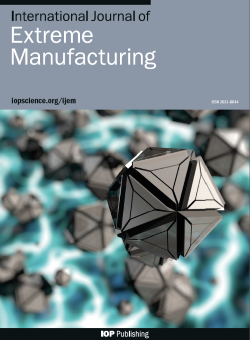超快准三维成像
IF 16.1
1区 工程技术
Q1 ENGINEERING, MANUFACTURING
引用次数: 3
摘要
了解具有复杂三维(3D)几何形状和极端性质演变的激光诱导超快过程为探索新的物理现象和克服制造限制提供了独特的机会。超高速成像提供了卓越的时空分辨率,因此被认为是一种有效的工具。然而,在传统的单视图成像技术中,3D信息被投影在二维平面上,这导致了严重的信息丢失,不利于了解整个超快过程。本文提出了一种准三维成像方法来描述激光诱导等离子体的超快过程,并进一步分析了激光诱导等离子体的空间不对称性。采用正交偏振激光脉冲照射反射-透射视图,采用二值化技术提取轮廓,形成相应的二维矩阵。通过旋转和乘以由对偶视图得到的二维轮廓矩阵,可以重建准三维图像。这成功地揭示了双相变机制,并阐明了发生在等离子体外的衍射现象。此外,准三维图像证实了皮秒等离子体的空间不对称性,这是二维图像难以实现的。我们的研究结果表明,准3d成像不仅可以比以往的成像方法更全面地了解等离子体动力学,而且在揭示强场物理、流体动力学和尖端制造等相关领域的各种复杂超快现象方面具有广阔的潜力。本文章由计算机程序翻译,如有差异,请以英文原文为准。
Ultrafast quasi-three-dimensional imaging
Understanding laser induced ultrafast processes with complex three-dimensional (3D) geometries and extreme property evolution offers a unique opportunity to explore novel physical phenomena and to overcome the manufacturing limitations. Ultrafast imaging offers exceptional spatiotemporal resolution and thus has been considered an effective tool. However, in conventional single-view imaging techniques, 3D information is projected on a two-dimensional plane, which leads to significant information loss that is detrimental to understanding the full ultrafast process. Here, we propose a quasi-3D imaging method to describe the ultrafast process and further analyze spatial asymmetries of laser induced plasma. Orthogonally polarized laser pulses are adopted to illuminate reflection-transmission views, and binarization techniques are employed to extract contours, forming the corresponding two-dimensional matrix. By rotating and multiplying the two-dimensional contour matrices obtained from the dual views, a quasi-3D image can be reconstructed. This successfully reveals dual-phase transition mechanisms and elucidates the diffraction phenomena occurring outside the plasma. Furthermore, the quasi-3D image confirms the spatial asymmetries of the picosecond plasma, which is difficult to achieve with two-dimensional images. Our findings demonstrate that quasi-3D imaging not only offers a more comprehensive understanding of plasma dynamics than previous imaging methods, but also has wide potential in revealing various complex ultrafast phenomena in related fields including strong-field physics, fluid dynamics, and cutting-edge manufacturing.
求助全文
通过发布文献求助,成功后即可免费获取论文全文。
去求助
来源期刊

International Journal of Extreme Manufacturing
Engineering-Industrial and Manufacturing Engineering
CiteScore
17.70
自引率
6.10%
发文量
83
审稿时长
12 weeks
期刊介绍:
The International Journal of Extreme Manufacturing (IJEM) focuses on publishing original articles and reviews related to the science and technology of manufacturing functional devices and systems with extreme dimensions and/or extreme functionalities. The journal covers a wide range of topics, from fundamental science to cutting-edge technologies that push the boundaries of currently known theories, methods, scales, environments, and performance. Extreme manufacturing encompasses various aspects such as manufacturing with extremely high energy density, ultrahigh precision, extremely small spatial and temporal scales, extremely intensive fields, and giant systems with extreme complexity and several factors. It encompasses multiple disciplines, including machinery, materials, optics, physics, chemistry, mechanics, and mathematics. The journal is interested in theories, processes, metrology, characterization, equipment, conditions, and system integration in extreme manufacturing. Additionally, it covers materials, structures, and devices with extreme functionalities.
 求助内容:
求助内容: 应助结果提醒方式:
应助结果提醒方式:


